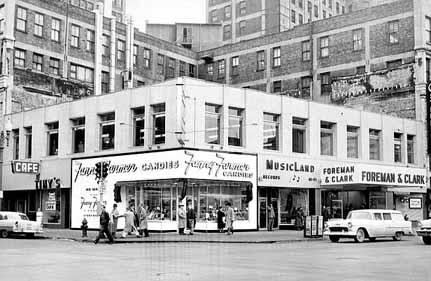Difference between revisions of "The Sandbox"
(No difference)
| |
Revision as of 20:12, 3 April 2010
Southeast Corner of Fifth Street and Hennepin Avenue, Minneapolis, MN
Like the Stonewall Inn in New York City, the Sandbox was a tiny, late-1960s establishment that catered to people we would identify today as transgender. At the time in the Twin Cities, these “female impersonators” made scant money by performing in the bar’s minuscule stage for audiences looking to be teased. The bar’s drag queens, effeminate men, and other gender non-conformers constituted the poorest economic class in the Twin Cities (see: Twin Cities Trans March]]), so their bar could not afford advertising in the Uptown Voice—the only GLBT publication the bar could have used for advertising.
| The Sandbox occupied a small amount of space in an even smaller building—the structure lost its third floor in a 1954 fire—that squatted in the southeastern corner of Fifth Street and Hennepin Avenue.
|
Fifth and Hennepin in the mid-1960s. The Sandbox/Roaring 20s likely opened in the "Tiny's" Space to the left. Image courtesy of the Minnesota Historical Society. |
One particular story ties the Sandbox even closer to the Stonewall Inn. Shortly before the bar closed, a group of drunken teenagers drove past and tossed a brick though the bar’s large plate glass window. “Almost simultaneously,” the racially mixed drag queens erupted out of the front door, saw the perpetrators driving away, and chased after them.
Local lore presents alternate endings to the story; the perpetrators escape in the first, and the drag queens return with a pride for their retaliation. In the second, the teens stop at a nearby stoplight, and the drag queens use their heels as clubs—causing serious damage to the vehicle. Had Minneapolis Police been present at this event, the result could easily have been a riot.
Information for this article is the result of an interview with Jean-Nickolaus Tretter, director of the Jean-Nickolaus Tretter Collection. 3/4/10.
Part of Minneapolis/St. Paul, MN: 100 Queer Places in Minnesota History, (1860-1969), (1969-2010)
